小学英语全英文教案范文
- 格式:doc
- 大小:34.00 KB
- 文档页数:8
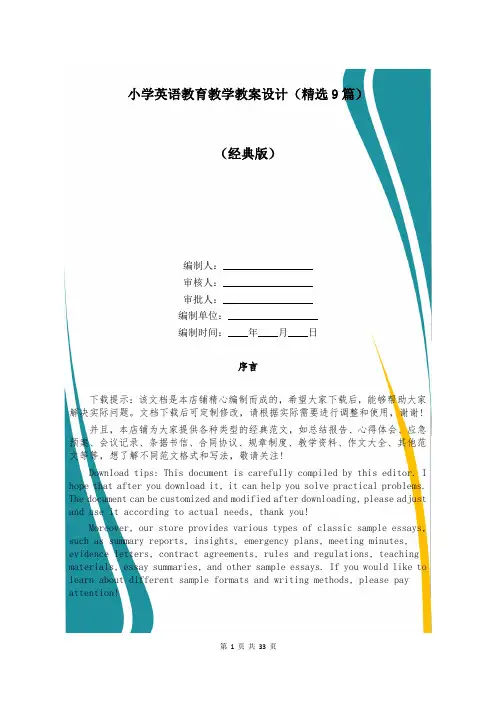
小学英语教育教学教案设计(精选9篇)(经典版)编制人:__________________审核人:__________________审批人:__________________编制单位:__________________编制时间:____年____月____日序言下载提示:该文档是本店铺精心编制而成的,希望大家下载后,能够帮助大家解决实际问题。
文档下载后可定制修改,请根据实际需要进行调整和使用,谢谢!并且,本店铺为大家提供各种类型的经典范文,如总结报告、心得体会、应急预案、会议记录、条据书信、合同协议、规章制度、教学资料、作文大全、其他范文等等,想了解不同范文格式和写法,敬请关注!Download tips: This document is carefully compiled by this editor. I hope that after you download it, it can help you solve practical problems. The document can be customized and modified after downloading, please adjust and use it according to actual needs, thank you!Moreover, our store provides various types of classic sample essays, such as summary reports, insights, emergency plans, meeting minutes, evidence letters, contract agreements, rules and regulations, teaching materials, essay summaries, and other sample essays. If you would like to learn about different sample formats and writing methods, please pay attention!小学英语教育教学教案设计(精选9篇)小学英语教育教学教案设计(精选9篇)2024-04-14 12:07:23小学英语教学设计(精选6篇)推荐度:小学英语教学设计范文最新6篇推荐度:热点范文英语(英文:English)是一种西日耳曼语支,最早被中世纪的英国使用,并因其广阔的殖民地而成为世界使用面积最广的语言。
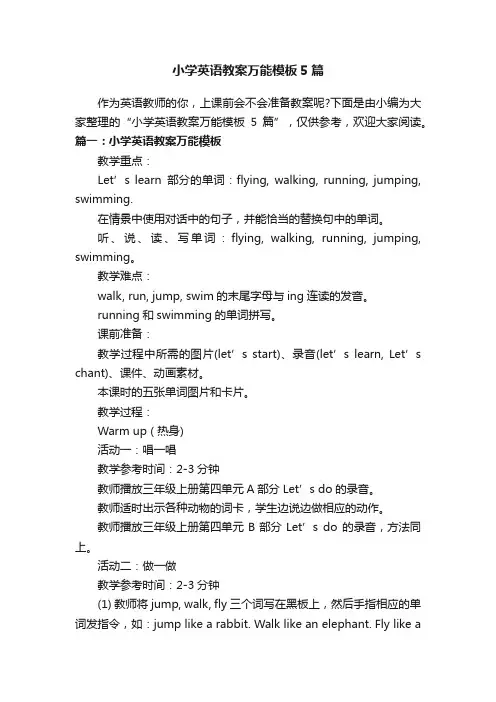
小学英语教案万能模板5篇作为英语教师的你,上课前会不会准备教案呢?下面是由小编为大家整理的“小学英语教案万能模板5篇”,仅供参考,欢迎大家阅读。
篇一:小学英语教案万能模板教学重点:Let’s learn部分的单词:flying, walking, running, jumping, swimming.在情景中使用对话中的句子,并能恰当的替换句中的单词。
听、说、读、写单词:flying, walking, running, jumping, swimming。
教学难点:walk, run, jump, swim的末尾字母与ing连读的发音。
running和swimming的单词拼写。
课前准备:教学过程中所需的图片(let’s start)、录音(let’s learn, Let’s chant)、课件、动画素材。
本课时的五张单词图片和卡片。
教学过程:Warm up ( 热身)活动一:唱一唱教学参考时间:2-3分钟教师播放三年级上册第四单元A部分Let’s do的录音。
教师适时出示各种动物的词卡,学生边说边做相应的动作。
教师播放三年级上册第四单元B部分Let’s do 的录音,方法同上。
活动二:做一做教学参考时间:2-3分钟(1) 教师将jump, walk, fly三个词写在黑板上,然后手指相应的单词发指令,如:jump like a rabbit. Walk like an elephant. Fly like abird.学生边跟读边做相应的动作。
(2) 教师继续发指令,学生做动作,适时提问:What are you doing?,引导学生回答:I’m (jumping) (like a rabbit).。
教师在黑板上的jump后面加上ing,呈现新词:jumping。
同法引入walking 和flying。
2、Presentation (新课呈现)活动三:学一学教学参考时间:10-12分钟教师出示Let’s learn部分的教学课件,提问:What animals can you see in the picture?让学生回答。
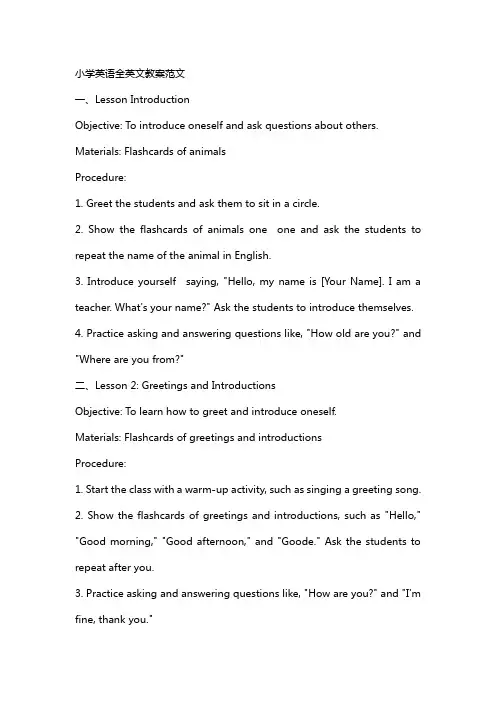
小学英语全英文教案范文一、Lesson IntroductionObjective: To introduce oneself and ask questions about others. Materials: Flashcards of animalsProcedure:1. Greet the students and ask them to sit in a circle.2. Show the flashcards of animals one one and ask the students to repeat the name of the animal in English.3. Introduce yourself saying, "Hello, my name is [Your Name]. I am a teacher. What's your name?" Ask the students to introduce themselves.4. Practice asking and answering questions like, "How old are you?" and "Where are you from?"二、Lesson 2: Greetings and IntroductionsObjective: To learn how to greet and introduce oneself.Materials: Flashcards of greetings and introductionsProcedure:1. Start the class with a warm-up activity, such as singing a greeting song.2. Show the flashcards of greetings and introductions, such as "Hello," "Good morning," "Good afternoon," and "Goode." Ask the students to repeat after you.3. Practice asking and answering questions like, "How are you?" and "I'm fine, thank you."4. Introduce a new student to the class and ask the students to greet and introduce themselves.三、Lesson 3: ColorsObjective: To learn how to name and describe colors in English. Materials: Flashcards of colorsProcedure:1. Start the class showing a colorful picture or object and ask the students to name the colors.2. Show the flashcards of colors one one and ask the students to repeat the color name in English.3. Practice describing colors using phrases like, "It's blue," "It's a red car," and "The sky is blue."4. Draw a colorful picture with the students and ask them to name the colors as you draw.四、Lesson 4: Numbers 1-10Objective: To learn how to count from 1 to 10 in English.Materials: Number flashcards, objects to countProcedure:1. Start the class counting with the students, "One, two, three, four, five." Continue counting up to 10.2. Show the number flashcards one one and ask the students to repeat the number in English.3. Give the students a set of objects, such as counters or toys, and ask them to count the objects using English numbers.4. Play a number game, such as "Simon Says" or "Number Memory," to reinforce the counting skills.五、Lesson 5: AlphabetObjective: To learn the English alphabet and the sounds of each letter. Materials: Alphabet flashcards, letter sounds chartProcedure:1. Start the class singing the "Alphabet Song" to familiarize the students with the English alphabet.2. Show the alphabet flashcards one one and ask the students to repeat the letter name in English.3. Expln the sounds of each letter in the alphabet using a letter sounds chart.4. Practice tracing the letters of the alphabet on a large whiteboard or chart paper, and ask the students to follow along.六、Lesson 6: Family MembersObjective: To learn how to name family members in English. Materials: Flashcards of family membersProcedure:1. Start the class asking the students about their family members in their native language.2. Introduce the concept of family members in English showing the flashcards of family members, such as "mother," "father," "brother," "sister," and "grandparent."3. Practice asking and answering questions about family members, like "Who is your mother?" and "I have a sister."4. Ask the students to bring a picture of their family and describe their family members in English.七、Lesson 7: Dly RoutinesObjective: To learn how to describe dly routines in English. Materials: Flashcards of dly routinesProcedure:1. Start the class discussing the dly routines of the students in their native language.2. Introduce the concept of dly routines in English showing the flashcards of dly routines, such as "wake up," "eat breakfast," "go to school," and "play."3. Practice asking and answering questions about dly routines, like "What do you do in the morning?" and "What do you do after school?"4. Ask the students to role-play their dly routines using English words and phrases.八、Lesson 8: ClothingObjective: To learn how to name and describe different types of clothingin English.Materials: Flashcards of clothingProcedure:1. Start the class discussing the types of clothing worn in different seasons.2. Introduce the concept of clothing in English showing the flashcards of different types of clothing, such as "shirt," "pants," "dress," "sunglasses," and "hat."3. Practice asking and answering questions about clothing, like "What are you wearing today?" and "I am wearing a skirt."4. Ask the students to bring a picture of themselves in different types of clothing and describe their clothing in English.九、Lesson 9: Food and DrinksObjective: To learn how to name and describe different foods and drinks in English.Materials: Flashcards of food and drinksProcedure:1. Start the class discussing the types of food and drinks liked the students.2. Introduce the concept of food and drinks in English showing the flashcards of different food and drink items, such as "apple," "banana," "orange," "milk," and "water."3. Practice asking and answering questions about food and drinks, like "What is your favorite fruit?" and "Can I have some water, please?"4. Ask the students to bring a picture of their favorite food or drink and describe it in English.十、Lesson 10: Review and AssessmentObjective: To review the topics covered in the previous lessons and assess the students' understanding.Materials: Review worksheets, flashcardsProcedure:1. Start the class reviewing the topics covered in the previous lessons, such as greetings, introductions, colors, numbers, family members, dly routines, clothing, food and drinks.2. Conduct a mini-assessment to evaluate the students' understanding asking them to answer questions related to the topics.3. Use flashcards to test the students' vocabulary retention asking them to name the items in English.4. Provide review worksheets for the students to plete, which include exercises like fill in the blanks, match the words with their pictures, and write short sentences using the learned vocabulary.5. Give feedback to the students on their performance and encourage them to continue practicing their English skills.重点和难点解析一、Lesson Introduction重点关注环节:Students' ability to ask and answer questions about themselves.难点解析:This lesson introduces the concept of asking and answering questions about oneself, which is a fundamental skill in language learning. The students may find it challenging to express their personal information accurately and confidently in English.二、Lesson 2: Greetings and Introductions重点关注环节:Students' ability to use greetings and introduce themselves.难点解析:Using proper greetings and introductions is crucial in dly munication. The students might struggle with remembering and applying the correct phrases in different situations.三、Lesson 3: Colors重点关注环节:Students' ability to name and describe colors in English. 难点解析:Naming and describing colors can be challenging for students, especially those whose native language does not use the same color palette as English.四、Lesson 4: Numbers 1-10重点关注环节:Students' ability to count from 1 to 10 in English.难点解析:Counting is a foundational math skill that can be difficult for students to master when learning a new language, as it involvesunderstanding the numerical system and sequencing.五、Lesson 5: Alphabet重点关注环节:Students' ability to recognize and pronounce each letter of the English alphabet.难点解析:The English alphabet may have letters that are not present in the students' native language, making it challenging for them to recognize and pronounce them correctly.六、Lesson 6: Family Members重点关注环节:Students' ability to name family members in English and ask about others'.难点解析:Understanding and using family vocabulary can be emotional and personal for students. They may find it difficult to remember the English words for extended family members or to ask about others' families.七、Lesson 7: Dly Routines重点关注环节:Students' ability to describe their dly routines in English. 难点解析:Describing routines involves sequencing and using past tense verbs, which can be plex for beginners to grasp.八、Lesson 8: Clothing重点关注环节:Students' ability to name and describe different types of clothing in English.难点解析:Clothing terms can be abstract and may not have directtranslations in students' native languages. Additionally, students may be self-conscious about discussing their attire.九、Lesson 9: Food and Drinks重点关注环节:Students' ability to name and describe different foods and drinks in English.难点解析:Food and drink vocabulary can be extensive, and students may have difficulty remembering the names of specific items or describing preferences.十、Lesson 10: Review and Assessment重点关注环节:Students' ability to review and apply the knowledge gned from the previous lessons.难点解析:Assessment can be stressful for students, especially if they feel unprepared. Ensuring that the review is prehensive and allows for individualized learning is crucial.这些教案环节涵盖了从自我介绍到日常生活中的各种主题,每个环节都有其特定的重点和难点。
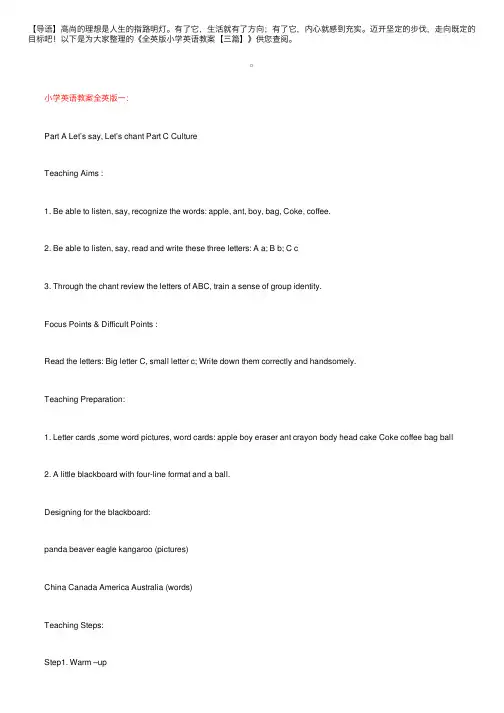
【导语】⾼尚的理想是⼈⽣的指路明灯。
有了它,⽣活就有了⽅向;有了它,内⼼就感到充实。
迈开坚定的步伐,⾛向既定的⽬标吧!以下是为⼤家整理的《全英版⼩学英语教案【三篇】》供您查阅。
⼩学英语教案全英版⼀: Part A Let’s say, Let’s chant Part C Culture Teaching Aims : 1. Be able to listen, say, recognize the words: apple, ant, boy, bag, Coke, coffee. 2. Be able to listen, say, read and write these three letters: A a; B b; C c 3. Through the chant review the letters of ABC, train a sense of group identity. Focus Points & Difficult Points : Read the letters: Big letter C, small letter c; Write down them correctly and handsomely. Teaching Preparation: 1. Letter cards ,some word pictures, word cards: apple boy eraser ant crayon body head cake Coke coffee bag ball 2. A little blackboard with four-line format and a ball. Designing for the blackboard: panda beaver eagle kangaroo (pictures) China Canada America Australia (words) Teaching Steps: Step1. Warm –up 1. Sing a song. 2. Free talk T: Hello. I’m Wendy. I’m from Hangzhou. S1: Hello! I’m ... I’m from Hangzhou,too. T: Nice to meet you. S: Nice to meet you, too. T: Let’s play. Ok? S: Great! T: Watch out! (T throws the ball.) S: Oh, no. Make a similar dialogue with your partner. Step2.Presentation. 1. 1)T : Today, we will learn letters. Do you know letters? Just as A,B,C…… They are letters. What’s the meaning of letters? S: 字母。
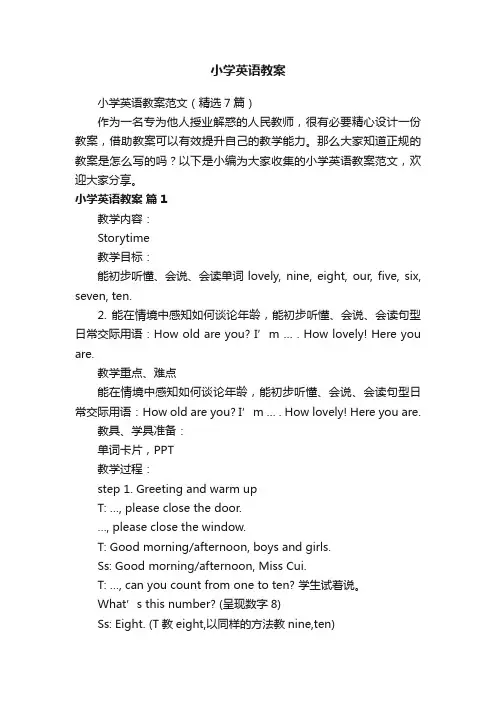
小学英语教案小学英语教案范文(精选7篇)作为一名专为他人授业解惑的人民教师,很有必要精心设计一份教案,借助教案可以有效提升自己的教学能力。
那么大家知道正规的教案是怎么写的吗?以下是小编为大家收集的小学英语教案范文,欢迎大家分享。
小学英语教案篇1教学内容:Storytime教学目标:能初步听懂、会说、会读单词lovely, nine, eight, our, five, six, seven, ten.2. 能在情境中感知如何谈论年龄,能初步听懂、会说、会读句型日常交际用语:How old are you? I’m … . How lovely! Here you are.教学重点、难点能在情境中感知如何谈论年龄,能初步听懂、会说、会读句型日常交际用语:How old are you? I’m … . How lovely! Here you are.教具、学具准备:单词卡片,PPT教学过程:step 1. Greeting and warm upT: …, please close the door.…, please close the window.T: Good morning/afternoon, boys and girls.Ss: Good morning/afternoon, Miss Cui.T: …, can you count from one to ten? 学生试着说。
What’s this number? (呈现数字8)Ss: Eight. (T教eight,以同样的方法教nine,ten)Step 2.Presentation and practice .T:(出示Mike, Helen, Tim的图片)Look, Helen is Mike’s brother. Mike is nine. And how old are you?Ss: I’m eight/nine /ten .新授句型,引导学生问答。
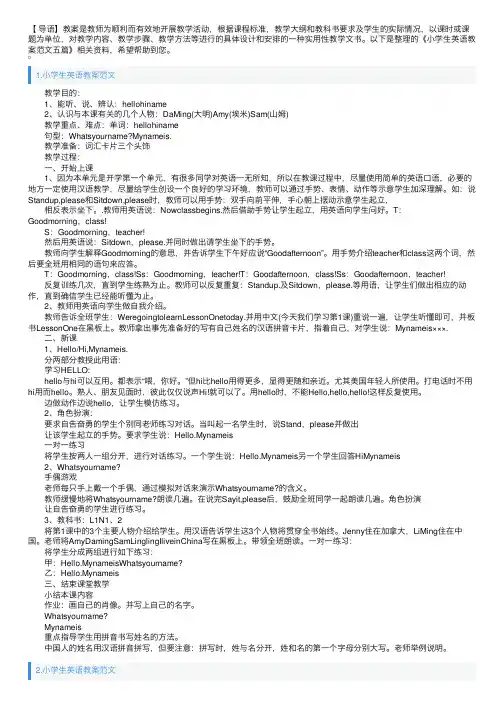
【导语】教案是教师为顺利⽽有效地开展教学活动,根据课程标准,教学⼤纲和教科书要求及学⽣的实际情况,以课时或课题为单位,对教学内容、教学步骤、教学⽅法等进⾏的具体设计和安排的⼀种实⽤性教学⽂书。
以下是整理的《⼩学⽣英语教案范⽂五篇》相关资料,希望帮助到您。
1.⼩学⽣英语教案范⽂ 教学⽬的: 1、能听、说、辨认:hellohiname 2、认识与本课有关的⼏个⼈物:DaMing(⼤明)Amy(埃⽶)Sam(⼭姆) 教学重点、难点:单词:hellohiname 句型:Whatsyourname?Mynameis. 教学准备:词汇卡⽚三个头饰 教学过程: ⼀、开始上课 1、因为本单元是开学第⼀个单元,有很多同学对英语⼀⽆所知,所以在教课过程中,尽量使⽤简单的英语⼝语,必要的地⽅⼀定使⽤汉语教学,尽量给学⽣创设⼀个良好的学习环境,教师可以通过⼿势、表情、动作等⽰意学⽣加深理解。
如:说Standup,please和Sitdown,please时,教师可以⽤⼿势:双⼿向前平伸,⼿⼼朝上摆动⽰意学⽣起⽴, 相反表⽰坐下。
.教师⽤英语说:Nowclassbegins.然后借助⼿势让学⽣起⽴,⽤英语向学⽣问好。
T:Goodmorning,class! S:Goodmorning,teacher! 然后⽤英语说:Sitdown,please.并同时做出请学⽣坐下的⼿势。
教师向学⽣解释Goodmorning的意思,并告诉学⽣下午好应说“Goodafternoon”。
⽤⼿势介绍teacher和class这两个词,然后要全班⽤相同的语句来应答。
T:Goodmorning,class!Ss:Goodmorning,teacher!T:Goodafternoon,class!Ss:Goodafternoon,teacher! 反复训练⼏次,直到学⽣练熟为⽌。
教师可以反复重复:Standup.及Sitdown,please.等⽤语,让学⽣们做出相应的动作,直到确信学⽣已经能听懂为⽌。

小学英语教案20篇英文版小学英语教学是教育的基础,也是每一个孩子学习英语的开端。
为了帮助小学英语老师更好地开展教学工作,提高孩子的英语学习成绩,以下是20篇小学英语教案的英文版,供广大小学英语教师参考。
1. Title: Introducing MyselfContent: Students learn to introduce themselves in English.Objectives: By the end of the class, students should be able to introduce themselves inEnglish.Materials: PPT, pictures, handoutsProcedure:1. Warm-up: Greeting students and asking them about their names.2. Presentation: Using pictures to introduce oneself and providing examples.3. Practice: Students practice introducing themselves in pairs.4. Production: Students present themselves in front of the class.5. Evaluation: Checking students’ pronunciation and fluency.2. Title: ColorsContent: Students learn how to recognize and say different colors in English.Objectives: By the end of the class, students should be able to recognize and name different colors in English.Materials: PPT, flashcards, handoutsProcedure:1.Warm-up: Using colored flashcards to engage students.2. Presentation: Using PPT to show pictures of different colors and their names.3. Practice: Students match the colors with their names and practice saying them.4. Production: Students createtheir own pictures and describe them in English.5. Evaluation: Checking students’ ability to recognize and name different colors.3. Title: NumbersContent: Students learn how to recognize and say the numbers from 1 to 20 in English.Objectives: By the end of the class, students should be able to recognize and say the numbers from 1 to 20 in English.Materials: PPT, flashcards, handoutsProcedure:1. Warm-up: Using number flashcards to engage students.2. Presentation: Using PPT to show pictures of the numbers from 1 to 20 and their names.3. Practice: Students match the numbers with their names and practice saying them.4. Production: Students practice counting in English and count the number of objects in the classroom.5. Evaluation: Checking students’ ability to recognize and say the numbers from 1 to 20.4. Title: ShapesContent: Students learn how to recognize and name different shapes in English.Objectives: By the end of the class, students should be able to recognize and name different shapes in English.Materials: PPT, flashcards, handoutsProcedure:1. Warm-up: Using shape flashcards to engage students.2. Presentation: Using PPT to show pictures of different shapes and their names.3. Practice: Students match the shapes with their names and practice saying them.4. Production: Students create their own pictures using different shapes and describe them in English.5. Evaluation: Checki ng students’ ability to recognize and name different shapes.5. Title: FamilyContent: Students learn how to talk about their family members in English.Objectives: By the end of the class, students should be able to talk about their family members in English.Materials: PPT, flashcards, handoutsProcedure:1.Warm-up: Asking students about their family members.2. Presentation: Using PPT to show pictures of different family members and their names.3. Practice: Students practice talking about their family members in pairs.4. Production: Students present their family members in front of the class.5. Evaluation: Checking students’ ability to talk about their family members in English.6. Title: AnimalsContent: Students learn how to recognize and name different animals in English.Objectives: By the end of the class, students should be able to recognize and name different animals in English.Materials: PPT, flashcards, handoutsProcedure:1. Warm-up: Using animal flashcards to engage students.2. Presentation: Using PPT to show pictures of different animals and their names.3. Practice: Students match the animals with their names and practice saying them.4. Production: Students create their own pictures using different animals and describe them in English.5. Evaluation: Chec king students’ ability to recognize and name different animals.7. Title: WeatherContent: Students learn how to recognize and name different types of weather in English.Objectives: By the end of the class, students should be able to recognize and name different types of weather in English.Materials: PPT, flashcards,handoutsProcedure:1. Warm-up: Asking students about the weather outside.2. Presentation: Using PPT to show pictures of different types of weather and their names.3. Practice: Students practice recognizing and naming different types of weather.4. Production: Students describe the weather in a particular place.5. Evaluation: Checking students’ ability to recognize and name different types of weather.8. Title: Food and DrinksContent: Students learn how to recognize and name different types of food and drinks in English.Objectives: By the end of the class, students should be able to recognize and name different types of food and drinks in English.Materials: PPT, flashcards, handoutsProcedure:1.Warm-up: Asking students about their favorite food and drinks.2. Presentation: Using PPT to show pictures of different types of food and drinks and their names.3. Practice: Students practice recognizing and naming different types of food and drinks.4. Production: Students decide on a menu and describe the food and drinks in English.5. Evaluation: Checking students’ ability to recognize and name different types of food and drinks.9. Title: My BodyContent: Students learn how to recognize and name different parts of the body in English.Objectives: By the end of the class, students should be able to recognize and name different parts of the body in English.Materials: PPT, flashcards, handoutsProcedure:1. Warm-up: Asking students about different parts of the body.2. Presentation: Using PPT to show pictures of different parts of the body and their names.3. Practice: Studentspractice recognizing and naming different parts of the body.4. Production: Students draw a person and label the different parts of the body in Eng lish.5. Evaluation: Checking students’ ability to recognize and name different parts of the body.10. Title: JobsContent: Students learn how to recognize and name different types of jobs in English.Objectives: By the end of the class, students should be able to recognize and name different types of jobs in English.Materials: PPT, flashcards, handoutsProcedure:1. Warm-up: Asking students about their dream job.2. Presentation: Using PPT to show pictures of different types of jobs and their names.3. Practice: Students practice recognizing and naming different types of jobs.4. Production: Students choose a job and describe it in English.5. Evaluation: Checking students’ ability to recognize and name different types of jobs.11. Title: Days of the WeekContent: Students learn how to recognize and say the days of the week in English.Objectives: By the end of the class, students should be able to recognize and say the days of the week in English.Materials: PPT, flashcards, handoutsProcedure:1. Warm-up: Asking students about their favorite day of the week.2. Presentation: Using PPT to show pictures of the days of the week and their names.3. Practice: Students practice recognizing and saying the days of the week.4. Production: Students describe their schedule for the week.5. Evaluation: Checking students’ ability to recognize and say the days of the week.12. Title: Months of the YearContent: Students learn how to recognize and say the months of the year in English.Objectives: By the end of the class, students should be able to recognize and say the months of the year in English.Materials: PPT, flashcards, handoutsProcedure:1. Warm-up: Asking students about their favorite month of the year.2. Presentation: Using PPT to show pictures of the months of the year and their names.3. Practice: Students practice recognizing and saying the months of the year.4. Production: Students describe their favorite season and the months that belong to it.5. Evaluation: Checking students’ ability to recognize and say the months of the year.13. Title: TimeContent: Students learn how to tell the time in English.Objectives: By the end of the class, students should be able to tell the time in English.Materials: PPT, flashcards, handoutsProcedure:1. Warm-up: Asking students about their favorite time of the day.2. Presentation: Using PPT to show pictures of the clock and different times.3. Practice: Students practice telling the time in English.4. Production: Students plan their daily schedule and write it in English.5. Evaluation: Checking students’ ability to tell the time in English.14. Title: Weather ForecastContent: Students learn how to give a weather forecast in English.Objectives: By the end of the class, students should be able to give a weather forecast in English.Materials: PPT, flashcards, handoutsProcedure:1.Warm-up: Asking students about the weather outside.2. Presentation: Using PPT to show different weather conditions andvocabulary.3. Practice: Students practice giving a weather forecast in pairs.4. Production: Students give a weather forecast in front of the class.5. Evaluation: Checking students’ ability to give a weather forecast in English.15. Title: SeasonsContent: Students learn how to recognize and name the different seasons in English.Objectives: By the end of the class, students should be able to recognize and name the different seasons in English.Materials: PPT, flashcards, handoutsProcedure:1. Warm-up: Asking students about their favorite season.2. Presentation: Using PPT to show pictures of the different seasons and their names.3. Practice: Students practice recognizing and naming the different seasons.4. Production: Students write a paragraph about their favorite season in English.5. Evaluation: Checking students’ ability to recognize and name the different seasons in English.16. Title: ToysContent: Students learn how to recognize and name different types of toys in English.Objectives: By the end of the class, students should be able to recognize and name different types of toys in English.Materials: PPT, flashcards, handoutsProcedure:1. Warm-up: Asking students about their favorite toy.2. Presentation: Using PPT to show pictures of different types of toys and their names.3. Practice: Students practice recognizing and naming different types of toys.4. Production: Students describe their favorite toy in English.5. Evaluation: Checking students’ ability to recognize and name different types of toys.17. Title: School SuppliesContent: Students learn how to recognize and name different school supplies in English.Objectives: By the end of the class, students should be able to recognize and name different school supplies in English.Materials: PPT, flashcards, handoutsProcedure:1. Warm-up: Asking students about their favorite school supply.2. Presentation: Using PPT to show pictures of different school supplies and their names.3. Practice: Students practice recognizing and naming different school supplies.4. Production: Students describe the contents of their school bag in English.5. Evaluation: Checking students’ ability to recognize and name different school supplies.18. Title: Parts of a HouseContent: Students learn how to recognize and name different parts of a house inEnglish.Objectives: By the end of the class, students should be able to recognize and name different parts of a house in English.Materials: PPT, flashcards, handoutsProcedure:1.Warm-up: Asking students about the different rooms in their house.2. Presentation: Using PPT to show pictures of different parts of a house and their names.3. Practice: Students practice recognizing and naming different parts of a house.4. Production: Students describe their favorite room in their house in English.5. Evaluation: Checking students’ ability to recognize and name different parts of a house.19. Title: HolidaysContent: Students learn how to recognize and name different holidays in English.Objectives: By the end of the class, students should be able to recognize and name differentholidays in English.Materials: PPT, flashcards, handoutsProcedure:1. Warm-up: Asking students about their favorite holiday.2. Presentation: Using PPT to show pictures of different holidays and their names.3. Practice: Students practice recognizing and naming different holidays.4. Production: Students write about their favorite holiday in English.5. Evaluation: Checking students’ ability to recognize and name different holidays in English.20. Title: SportsContent: Students learn how to recognize and name different sports in English.Objectives: By the end of the class, students should be able to recognize and name different sports in English.Materials: PPT, flashcards, handoutsProcedure:1. Warm-up: Asking students about their favorite sport.2. Presentation: Using PPT to show pictures of different sports and their names.3. Practice: Students practice recognizing and naming different sports.4. Production: Students describe their favorite sport in English.5. Evaluation: Checking students’ ability to recognize and name different sports in English.以上是20篇小学英语教案的英文版,它们覆盖了小学英语教学的各个方面。
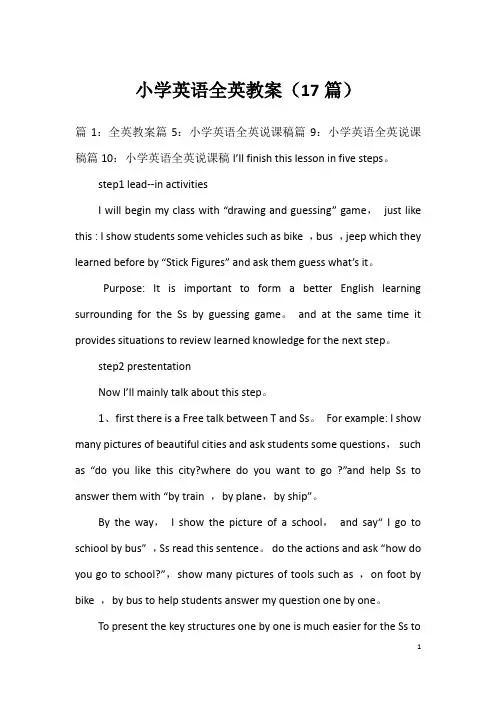
小学英语全英教案(17篇)篇1:全英教案篇5:小学英语全英说课稿篇9:小学英语全英说课稿篇10:小学英语全英说课稿I’ll finish this lesson in five steps。
step1 lead--in activitiesI will begin my class with “drawing and guessing” game,just like this : I show students some vehicles such as bike ,bus ,jeep which they learned before by “Stick Figures” and ask them guess what’s it。
Purpose: It is important to form a better English learning surrounding for the Ss by guessing game。
and at the same time it provides situations to review learned knowledge for the next step。
step2 prestentationNow I’ll mainly talk about this step。
1、first there is a Free talk between T and Ss。
For example: I show many pictures of beautiful cities and ask students some questions,such as “do you like this city?where do you want to go ?”and help Ss to answer them with “by train ,by plane,by ship”。
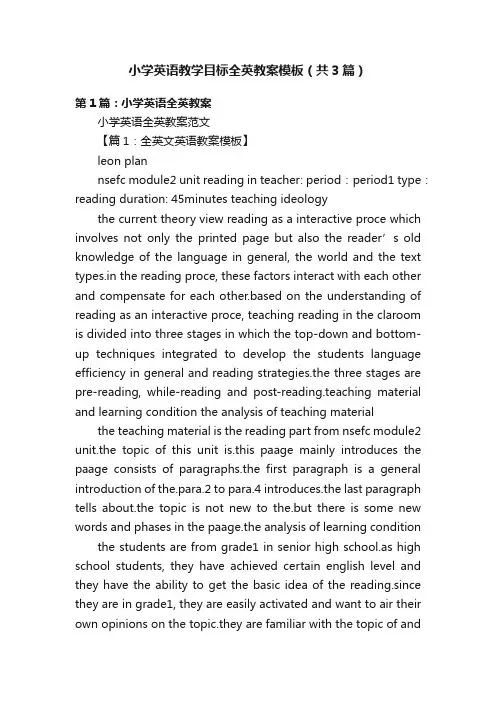
小学英语教学目标全英教案模板(共3篇)第1篇:小学英语全英教案小学英语全英教案范文【篇1:全英文英语教案模板】leon plannsefc module2 unit reading in teacher: period:period1 type:reading duration: 45minutes teaching ideologythe current theory view reading as a interactive proce which involves not only the printed page but also the reader’s old knowledge of the language in general, the world and the text types.in the reading proce, these factors interact with each other and compensate for each other.based on the understanding of reading as an interactive proce, teaching reading in the claroom is divided into three stages in which the top-down and bottom-up techniques integrated to develop the students language efficiency in general and reading strategies.the three stages are pre-reading, while-reading and post-reading.teaching material and learning condition the analysis of teaching material the teaching material is the reading part from nsefc module2 unit.the topic of this unit is.this paage mainly introduces the paage consists of paragraphs.the first paragraph is a general introduction of the.para.2 to para.4 introduces.the last paragraph tells about.the topic is not new to the.but there is some new words and phases in the paage.the analysis of learning condition the students are from grade1 in senior high school.as high school students, they have achieved certain english level and they have the ability to get the basic idea of the reading.since they are in grade1, they are easily activated and want to air their own opinions on the topic.they are familiar with the topic of andknow some.but they may not know before.moreover, their vocabulary is limited so they may have difficulties in understanding some sentences.learning objectives nguage skills ? at the beginning of the cla, can predict the content of the paage based on the title.? can scan the paage and find out the specific information such as the person related withcan summarize the paage with the help of the clues of the nguage knowledgecan master the key words and phrases of the paage as follows,.? can learn , especially 3.affectswill realize that and they will concern themselves with the iue of4.cultural awarenewill broaden their minds by knowing something about 5.learning strategieswill cultivate their ability individual learning and cooperative learning by doing someactivities independently and some in groups.? will communicate with each other in english while doing the group nguage difficultiesfocuses and anticipated language focusesthis is a reading period so the focus is to cultivate the students’ reading skills.the many activities are designed to help to train their reading skills, such as predicting, skimming, scanning and summarizing.it is also important for the to master the new words and phrases.anticipated difficultiesas the have a limited vocabulary, so they may have some difficulties in understanding the paage.so the teacher will help them learn the new words and phrases.may did not heard before, so the teacher will tell them some background knowledge aboutit.teaching methodthree-stage model: based on the understanding of reading as an interactive proce, teaching reading in the claroom is divided into three stages in which the top-down and bottom-up techniques integrated to develop the students language efficiency in general and reading strategies.the three stages are pre-reading, while-reading and post-reading.teaching aids multimedia devices and ppt documents: in order to help to fully understand the whole paage, i adopt multimedia devices and ppt documents to bring the real-life situation into the claroom.teaching procedures step1.lead-in(6min)activity1.greetings and free-talking(2min)t leads into the topic by asking some they know.tell the name of the they know freely.t: hello boys and girls.(say hello to the teacher.)t: when we say , what appears in your minds?(tell the things appear in their minds freely.)t: what are the ?(tell some names of.) activity2.picture-talking(4min)t shows some pictures about the in china and abroad.after seeing the pictures, are expected to tell the similarities of them.t: just now, you talk about some in china.now, let’s see some pictures of some.(t shows the pictures and see them carefully.) t: what do the have in common?for example, they are very precious.what are your opinions?(t gives them some hints and tell the characteristics of)[aims] in this step, t first leads in the topic by talking with the freely about the whichis familiar to them and then see some pictures and tell the characteristics.these two activities aim to arouse the ’ interests in the topic and activate their old knowledge of.then will bementally prepared for the reading comprehension.what’s more,when they are talking about the charateristics of, they will realize that theare rare and precious and they will concern themselves with the iue of.step2.pre-reading(3min)activity1.knowing something about(1min)t gives a brief introduction of the.will know the t: today, we are going to learn.it is.do you know what is?(t shows some pictures ofand get to know the.)activity2.predicting(2min)t asks to read the title of the paage and then ask them some questions.will predict the content of the paage with the help of the title.t: please look at the ti tle “”, what does “” mean?(if the can not give the answer, then t explain it.)t: in search means that people are looking for it.why are people looking for it? can you gue? what will the paage talk about?(predict the content, but t will not give the answer here.)[aims] in this step, the first know some information of the;the background information will make it easier for the to understand the paage.then t asks to make predictions about the paage.it aims to help develop the reading skills of predicting.step3.while-reading(22min)activity1.skimming(4min)skim the whole paage and find out and check their predictions.t: why are people still ? here is a multiple choice for you.activity2.scanning(3min)t presents several true or false statements and asks the to scan the paage and judge the right from the wrong.(keys: F,F,T,T,F)activity3 close-reading(15min)t designs various kinds of activities and do the activities to fully understand the paage.para.1t: please read para.1 carefully and then take some note aboutthe.para.2-4please read para.2-4 carefully and then find out the removal of the room.please read para.2-4 carefully and then find out the person related with the amber room and the things them down with it.para.5 please read para.5 carefully and then find out the the rebuilding of the amber room.【篇2:pep小学英语全英教案模板】the english teaching plan of pep book 4enhe primary school teacher:___________ the curriculum schedule cla:____________ cla:____________ the teaching schedule the students’ result tablethe english curriculum standard英语课程标准一级目标总体目标:对英语有好奇心,喜欢听他人说英语;能根据教师的简单指令做游戏、做动作、做事情(如涂颜色、连线);能做简单的角色扮演;能唱简单的英文歌曲,说简单的英语歌谣;能在图片的帮助下听懂和读懂简单的小故事;能交流简单的个人信息,表达简单的情感和感觉;能书写字母和单词;对英语学习中接触的外国文化习俗感兴趣。
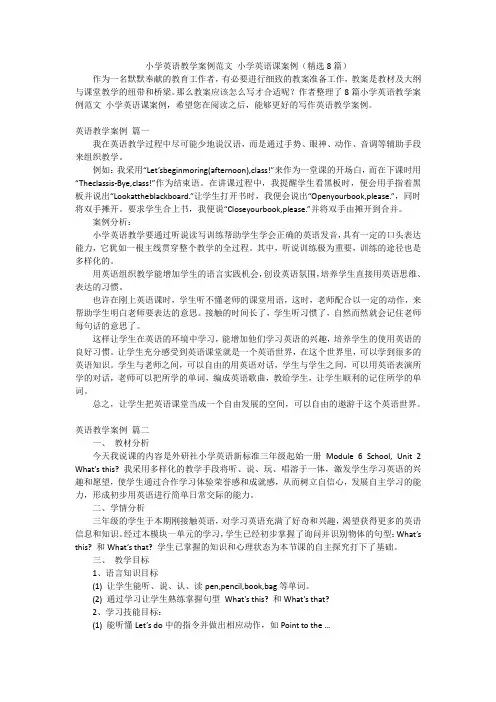
小学英语教学案例范文小学英语课案例(精选8篇)作为一名默默奉献的教育工作者,有必要进行细致的教案准备工作,教案是教材及大纲与课堂教学的纽带和桥梁。
那么教案应该怎么写才合适呢?作者整理了8篇小学英语教学案例范文小学英语课案例,希望您在阅读之后,能够更好的写作英语教学案例。
英语教学案例篇一我在英语教学过程中尽可能少地说汉语,而是通过手势、眼神、动作、音调等辅助手段来组织教学。
例如:我采用“Let’sbeginmoring(afternoon),class!”来作为一堂课的开场白,而在下课时用“Theclassis-Bye,class!”作为结束语。
在讲课过程中,我提醒学生看黑板时,便会用手指着黑板并说出“Lookattheblackboard.”让学生打开书时,我便会说出“Openyourbook,please.”,同时将双手摊开。
要求学生合上书,我便说“Closeyourbook,please.”并将双手由摊开到合并。
案例分析:小学英语教学要通过听说读写训练帮助学生学会正确的英语发音,具有一定的口头表达能力,它犹如一根主线贯穿整个教学的全过程。
其中,听说训练极为重要,训练的途径也是多样化的。
用英语组织教学能增加学生的语言实践机会,创设英语氛围,培养学生直接用英语思维、表达的习惯。
也许在刚上英语课时,学生听不懂老师的课堂用语,这时,老师配合以一定的动作,来帮助学生明白老师要表达的意思。
接触的时间长了,学生听习惯了,自然而然就会记住老师每句话的意思了。
这样让学生在英语的环境中学习,能增加他们学习英语的兴趣,培养学生的使用英语的良好习惯。
让学生充分感受到英语课堂就是一个英语世界,在这个世界里,可以学到很多的英语知识。
学生与老师之间,可以自由的用英语对话,学生与学生之间,可以用英语表演所学的对话,老师可以把所学的单词,编成英语歌曲,教给学生,让学生顺利的记住所学的单词。
总之,让学生把英语课堂当成一个自由发展的空间,可以自由的遨游于这个英语世界。
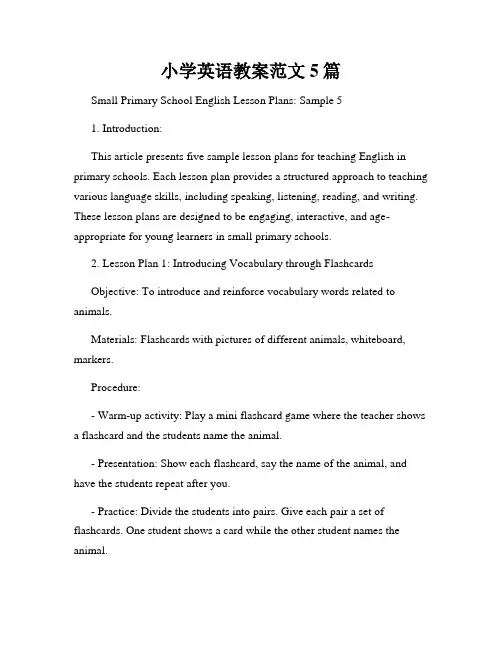
小学英语教案范文5篇Small Primary School English Lesson Plans: Sample 51. Introduction:This article presents five sample lesson plans for teaching English in primary schools. Each lesson plan provides a structured approach to teaching various language skills, including speaking, listening, reading, and writing. These lesson plans are designed to be engaging, interactive, and age-appropriate for young learners in small primary schools.2. Lesson Plan 1: Introducing Vocabulary through FlashcardsObjective: To introduce and reinforce vocabulary words related to animals.Materials: Flashcards with pictures of different animals, whiteboard, markers.Procedure:- Warm-up activity: Play a mini flashcard game where the teacher shows a flashcard and the students name the animal.- Presentation: Show each flashcard, say the name of the animal, and have the students repeat after you.- Practice: Divide the students into pairs. Give each pair a set of flashcards. One student shows a card while the other student names the animal.- Review: Ask the students questions using the flashcards to assess their understanding.3. Lesson Plan 2: Listening Comprehension through SongsObjective: To improve listening skills and comprehension through songs.Materials: Song lyrics, audio player.Procedure:- Warm-up activity: Sing a familiar English song with the students.- Presentation: Introduce a new song by playing the audio and displaying the lyrics on the board.- Practice: Play the song multiple times, encouraging students to listen and sing along.- Comprehension activity: Ask questions related to the song lyrics and check the students' understanding.4. Lesson Plan 3: Reading and Writing Practice through StorytellingObjective: To develop reading and writing skills through storytelling.Materials: A storybook with pictures, a whiteboard, markers.Procedure:- Warm-up activity: Ask the students if they enjoy reading stories and encourage them to share their favorite stories.- Presentation: Show the book's cover and briefly introduce the main characters and setting.- Storytelling: Read the story aloud, emphasizing the pronunciation and intonation.- Comprehension and writing practice: Divide the students into groups and assign each group a different scene from the story to illustrate and write a short description.- Presentation and feedback: Each group presents their work and receives feedback from the teacher and classmates.5. Lesson Plan 4: Speaking and Listening ActivitiesObjective: To improve speaking and listening skills through pairwork and groupwork.Materials: Picture cards, a timer.Procedure:- Warm-up activity: Show a picture card and ask the students to describe what they see.- Pairwork: Divide the students into pairs. Each pair receives a set of picture cards. One student describes a picture while the other listens and guesses what it is.- Groupwork: Create small groups and give each group a topic. Students take turns discussing the topic within their group.- Reflection: Ask the students to share what they learned from their group discussions.6. Lesson Plan 5: Grammar Practice through Fun ExercisesObjective: To reinforce grammar knowledge through interactive exercises.Materials: Worksheets with grammar exercises, colored pencils.Procedure:- Warm-up activity: Engage the students by asking them to identify different parts of speech in a simple sentence.- Grammar exercises: Distribute the worksheets and guide the students through each exercise step by step.- Peer-check: Students exchange their worksheets and check each other's answers.- Review: Go through the correct answers together, addressing any misconceptions.7. Conclusion:These sample lesson plans demonstrate various approaches to effectively teach English in small primary schools. By incorporating different activities, such as vocabulary flashcards, songs, storytelling, speaking and listening tasks, and grammar exercises, teachers can create engaging and interactive lessons that promote language learning and development for young learners.。
小学英语教学设计英文版范文英语教学设计日臻精致、完美,行之有效和富于独创性,以极大地刺激学生的学习情绪,满足他们的学习欲求,构成师生之间和谐愉悦的课堂氛围。
下面是小编整理的小学英语教学设计英文版5篇,欢迎大家阅读分享借鉴,希望大家喜欢,也希望对大家有所帮助。
小学英语教学设计英文版1教学目标1能够圈出相同的字母,熟练认读26个英文字母。
2数出文具单词的数量,听说认读AB部分Let’s learn的8个文具的单词:crayon,pencil,pen,eraser,ruler,bag,book,pencil-box。
教学重难点教学重点:1字母的认读;2听说认读8个文具的单词:crayon,pencil,eraser,ruler,bag,book,pen,pencil box。
教学难点:较准确读出各单词,尤其是crayon和eraser两个单词的发音。
教学工具ppt课件教学过程ⅠGreetingsT: Hello,boysand girls. Ss: Hello, Miss Ren.T: Hello,I’mMiss Ren. S: Hello,I’m....T: Hello,What’syour name? S: My name’s.....ⅡPresentation1 I have somefriends.Let’s say hello to them.通过与字母打招呼,复习26个字母。
2 We have somany new friends. Are you happy? Let’s singtogether.师生齐唱字母歌,复习巩固字母。
3 the letter“a”made some new friends.He has a show for us. 通过字母秀的形式引出文具单词,并通过短语Showme your..... Open your.... Close your.... Carry your....操练单词。
小学英语全英文教案范文全英版你们觉得小学英语老师在备案时,用的全中文还是全英文 ?下面是学习啦小编带来小学英语全英文教案设计范文,希望对大家有帮助。
小学英语全英文教案范文篇 1Uni t 1 Les s on 3P ar t A Let s s ay , Let s chant Par t C Cul t ur eT eac hi ng Ai ms:1. B e a bl e t o l i s t en, s ay , r ec ogni z e t he wor ds : appl e,ant ,boy,bag,Cok e, c of f ee.2. B e a bl e t o l i st en, s ay , r ead a nd wr i t e t hes e t hr ee l et t er s :A a; B b;C c3.T hr ough t he c hant r ev i ew t he l et t er s o f A BC, t r ai n a s ens e of gr oup i dent i t y.F oc us Poi nt s D i f f i c ul t Poi nt s:R ead t he l et t er s : Bi g l et t er C,s mal l l et t er c ; Wr i t e down t hem c or r ec t l y and hands omel y.T eac hi ng Pr epar at i on:1.Let t er c ar ds , s ome wor d p i ct ur es , appl e boy er as er ant c r ay on body head cof f ee bag bal l wor d c ar ds : c ak e Cok e2. A l i t t l e bl ac k boar d wi t h f our - l i ne f or mat anda bal l.D es i gni ng f or t he bl ac kboar d:p anda beav er eagl e k angar oo ( pi c t ur es )C hi na Canada Amer i c a Aus t r al i a ( wor ds )T eac hi ng St eps :S t ep1. War m up1.Si ng a s ong.2.Fr ee t al kT:Hel l o.I m Wendy.I m f r om Hangz hou.S1:Hel l o!I m ...I m f r om Hangz hou, t oo.T:Ni c e t o meet you.S:Ni c e t o meet you,t oo.T: Let s pl ay. Ok ? S :Gr eat !T:Wat c h out ! ( T t hr ows t he bal l.)S:Oh,no.M ak e a s i mi l ar di al ogue wi t h y our par t ner.S t ep2. Pr es ent at i on.1.1) T:Today,we wi l l l ear n l et t er s. Do y ouknow l et t er s ? J us t a s A, B, C T hey ar e l et t er s. W hat s t he meani ng of l et t er s ?S: 字母。
小学英语全英文教案小学英语全英文教案「篇一」Theme: DiscussionFunction: Presenting different points of view。
Target Language: What do you suggest? What about ? Why don't you ? How about?I think so. I don't think so。
Vocabulary: suggest, quickly, excited, America, Chinese, kind, dragon, same, circlePronunciation: / / / / / / / /Poem: Do you agree?一、Warmer:1. Draw some pictures to help the Ss to learn the words: some chopsticks, a dragon, a kite, a radio, a CD2. Put the pictures on the board, then the teacher call out the names of the pictures and let the Ss point them。
二、Presentation:1. Look, listen and learn:A. Tell the Ss that you are going to play a dialogue. The Ss have to listen and tell you what things they are thinking of giving to the cousin。
B. They have to listen to the objects that are suggested in the text。
C. Tell the Ss to close their books. Play the dialogue and get the Ss to listen and note down their answers. Then ask them what objects they heard were mentioned。
【导语】教育者有⽬的有计划有组织的对受教育者的⾝⼼发展进⾏教化培育,以现有的经验、学识推敲于⼈,为其解释各种现象、问题或⾏为,以增长能⼒经验。
以下是为⼤家整理的《⼩学英语教案全英⽂版【三篇】》供您查阅。
【篇⼀】TEACHING PROCEDURESI、Warming-upStep one:Let’s the student listen to the tape.And review some adj. about weather.Eg:warm,cool,hot,cold.Let the students do actions while listening.Step two:Do an exercise.The teacher will ask some questions about the listen test.It's about part B read and write in grade five.Eg:What's your favourite (II)previewStep one:ask and answerThe teacher is going to ask some questions. (eg:what is the weather like?)And show off the different pictures about weather. Guide students to answer questions by using warm,cool,hot.III、PresentationLet's learnStep one:words studyDraw a trunk on the blackboard,and then add some light green leaves.Ask students(look!The leaves are green now.What season is it now?) Show off the word card "season".Teach them "season".After that,show off "spring".Students read after the teacher.And describe the weather of "spring" character depend on their owe life.(eg:spring is warm in hangzhou/taiwan.) Then point at the main city on the map,and ask what is the weather like in beijing/shenzhen? Spell together.Step two:continute to add deep green leaves on the tree.And say look!The leaves are becoming more and more.Summer is coming.Teach "summer"in the same way.Step three:draw the sun and ligth,and acquit very hot.Ask oh,what is the weather like in summer?Guide students to answer it. It's hot,very very hot.Step four:clean parts of leaves and light,and then colour some leaves into yellow.Ask look!Now it's cool.What season is it now?Oh.It's fall now.Writing "fall" on the board.Spell together.Step five:clean parts of leaves,and then add some cloudy and snow.Say"now,the weather is very cold.It is winter now.".Teach "winter".Ask and answer:"what is the weather like in winter in ……?"Step six:show off different picture about weather,and ask and answer.Eg:T:What's the weather like?S:It's windy.T:What season is it now?S:Spring.ect.Continu to ask a question"what's your favourite season?"Guide students to answer it.Let's startStep one:show off different picture about seasons.Ask"what's the weather like in this picture?"Step two:Play a gameTeacher shows the picture in different seasons.In order to see who can correctly say the first word, the winners must give incentives.Step three:Guide students to use patterns of small groups. And finish let's start .(eg:what's your favourite season?……because it's ……)Consolidation and extensionLet student do some exercise which is from student exercise book.【篇⼆】After some practice by asking and answering, I present the next language points:There’s no …inon ear…Have …then.And I will stick these sentence patterns on the Bb. Finally I’ll let the Ss do pair works to consolidate them.Step 3 Listen to the tape and Ss imitate to read and say.As the new reformation of curriculum, emphasized the traditional class attach importance to the mechanical teaching, neglect the experience and participation, for example, the five-step method. So in this lesson, after presentation, I ask Ss to listen to the tape with three Qs, read in different roles and in pairs, then try to recite the text.Step 4 Ss be the main body, T makes a guider.In class, Ss play as a host, and the T makes an influence on guiding, help Ss to act the learnt dialogue, it can stress the position of the Ss, and arouse their interest.Then I show a carton with no voice, ask Ss to make a dialogue in pairs.There are lots of ways to consolidate the new knowledge. Playing game is a good way. So according to the physiology of Ss, I hold a group competition during the game, ask Ss to finish the blanks. In this way can develop Ss’ good habits and achieve the aim of mastering the learned knowledge in situation.Step 5 Change class to life, learn by themselves.Is this the end of the class? I don’t think so. If there is an end, I think it should be in the life. So I extend this class, encourage Ss to use the learned to communicate with each other in their life.In a word, the whole period is based on tasks, which are designed from easy steps to steps that are challenging. When the Ss are carting out the tasks, they can acquire information, knowledge, and have their ability and skills trained.That’s all. Thanks a lot for your attention.【篇三】Part A Let’s say, Let’s chant Part C CultureTeaching Aims :1. Be able to listen, say, recognize the words: apple, ant, boy, bag, Coke, coffee.2. Be able to listen, say, read and write these three letters: A a; B b; C c3. Through the chant review the letters of ABC, train a sense of group identity.Focus Points & Difficult Points :Read the letters: Big letter C, small letter c; Write down them correctly and handsomely.Teaching Preparation:1. Letter cards ,some word pictures, word cards: apple boy eraser ant crayon body head cake Coke coffee bag ball2. A little blackboard with four-line format and a ball.Designing for the blackboard:panda beaver eagle kangaroo (pictures)China Canada America Australia (words)Teaching Steps:Step1. Warm –up1. Sing a song.2. Free talkT: Hello. I’m Wendy. I’m from Hangzhou.S1: Hello! I’m ... I’m from Hangzhou,too.T: Nice to meet you.S: Nice to meet you, too.T: Let’s play. Ok?S: Great!T: Watch out! (T throws the ball.)S: Oh, no.Make a similar dialogue with yourpartner.Step2.Presentation.1. 1)T : Today, we will learn letters. Do you know letters? Just as A,B,C…… They are letters. What’s the meaning of letters?S: 字母。
小学英语教案模板范文5篇小学英语教案模板范文1一、教材分析:本课是冀教版小学英语(三年级起始版)第四册第三单元(All about me)的第4个新授课,Lesson16:How do you go to school? 经过一年半的学习,四年级下学期孩子们学习的重点逐渐过渡到各种基本句型。
本单元前面三课分别学习了关于年龄、身高、住处的句子,本课教材以How do you go to school?为切入点,重点学习关于出行方式的交流:询问别人、介绍自己的出行方式。
二、学生分析:孩子们经过一年半的学习,基本了解了字母:26个字母及常见字母组合的发音规则,词汇的学习方法:单词音形意用的结合、音节、重音及不同词类(名、动、数、形、冠等)的用法特点,初步体会英语句子的语序与汉语的不同,但对于句子结构及变化还比较陌生。
本课内容对于孩子们来说并不陌生,Book3 L16已学习过四种出行方式by bus, by car, by bike, by taxi和句子:How do you go to school? I go to school by ____? 另一种出行方式on foot /walk,dives me及选择此种出行方式的原因表述学生相对陌生。
但我校学生学习英语较早,一二年级有了两年的口语学习,还有近1/3有课外学习经历或正在进行,这些内容对于他们可能都不陌生。
基于以上分析,本课时目标制定如下。
三、教学目标:1、知识技能目标:A. 学生能够运用所学句型Do you walk to school? How do you go to school?I go to ___ by___ / on foot...询问、表达适合自己的出行方式。
B. 学生知道句子的变化是和人称有关系的,并能尝试运用所学句子介绍和询问他人的出行方式:Does he/she walk to school? How dooes he/she go to school? He/she goes to school by___ / on foot...2、文化目标:尝试了解不同地区人们选择不同出行方式:山区孩子、牧民(草原)、江南居民及西方国家等。
小学英语教案全英文版(优秀13篇)小学英语全英文教案范文篇一Goood moring, Im glad to interpret my lesson here . The lesson plan I am going to talk about is Part A lets learn of unit1 PEP Primary English book7. I will explain how to teach and the reason for doing this from following aspects.Ⅰ analysis of the teaching content.Ⅰ ways of teaching and learning .Ⅰ teaching proceduresⅠ blackboard designV assessmentNow Let;s focus on the analysis of teaching content. It can be divided into 3 parts as followed: the status and the function, the teaching objectives , the main points and difficult points, I;ll talk about it one by one.This lesson is the first lesson of unit 1, book7 . It includes two parts: Let;s learn and let;s play. In section 1, it mainly deals with these key phrases: on foot, by bike, by bus, by train, by subway. And in section 2, it provides a game for the Ss to prastise the patterns: How do you go to? And the answer: I go by../ on foot.Our students have already known some vehicles in the daily life. It;s not difficult for them to understand and use these words . If students can learn it well, it will help students to learn the rest of this unit. So, I set the following aims:The first is language objectivesTo make sure that students can read, recognize and use these key phrases :on foot ,by bike,by bus,by train skillfully.The next is ability objectives(1) To develop Ss; abilities of listening and speaking.(2) To train the Ss; ability of working in groups.moral objectives(1)to help students know some vehicles and comprehend the traffic rules(2) To foster Ss; consciousness of good co-operation and proper competition.The main points and difficult points about this lesson is:(1) To make sure that Ss can use these key phrases correctly and skillfully.(2) To enable Ss to study in groups and co-operate skillfully.(3) To develop Ss; interest in English.Difficult pointsTo help the Ss ask and answer the question “How do you go to?part Ⅰways of teaching and learningAs we all know: the main instructional aims of learning English in primary school is to cultivate pupils; basic abilities of listening and speaking and their good sense of the English language. So in this lesson I;ll mainly use “Task-based” teaching method. That is to say, I will let the Ss learn in real situations, finish a task by making a survey”How do you go to school?” to help Ss to get a better understanding of the key phrases. I will arrange these activities: guessing game, finishing a survey and having a competition. And in this lesson a recorder, CAI, will be needed.partⅠ teaching proceduresI;ll finish this lesson in five steps.step1 lead--in activitiesI will begin my class with drawing and guessing game, just like this : I show students some vehicles such as bike ,bus ,jeep which they learned before by Stick Figures and ask them guess what;s it.Purpose: It is important to form a better English learning surrounding for the Ss by guessing game. and at the same time it provides situations to review learned knowledge for the next step.step2 prestentationNow I;ll mainly talk about this step.1、first there is a Free talk between T and Ss. For example: I show many pictures of beautiful cities and ask students some questions, such as do you like this city?where do you want to go ?and help Ss to answer them with by train ,by plane,by ship.By the way, I show the picture of a school, and say“ I go to schiool by bus” ,Ss read this sentence. do the actions and ask how do you go to school?,show many pictures of tools such as ,on foot by bike ,by bus to help students answer my question one by one.To present the key structures one by one is much easier for the Ss to learn and grasp the meanings.2 With the help of the CAI I set a situation to help Ss understand the way of using these key phrases:A boy is coming, who is going to school. He says: I go to school byThen play the sounds of bus, bike ask students to listen carefully and tell “I go to school by according to the different sounds, by the way , I present another new phrases:by subwayPurpose:Make Ss use these new phrases with sentence structures, to help Ss use the language in a real situation.step3 practise3 I order to make every student read these new phrases correctly, I design a drill in this step,I show cards as soon as possible ,students should read the words quickly and spell them. Then I ask How do you go to school?students answer I go to ......also I will quicken the speed to ask .The purpose is to draw the whole studentsattention to the spelling of the words4 After this, I ask Ss to do Lets play in fours. They use places cards and vehicle cards, ask and answer:How do you go to ? I go to by”5, If Ss can ask and answer expertly, I will ask them to make a short dialogue.the purpose of this is to help students to learn those sentenses through a ture situation and make the dialogues in order to check if Ss can usse these key prases、sentences structures skillfullystep 4 consolidationlet students do a survey about how do you go to school?and the table like this :write down names and tools another Ss chooseTask-based teaching method is used here to develop Ss; ability of ; communication and also their ability of co-operation will be well trained.step 5 homeworkask students to collect other kinds of transport tools through the library ,computer.the purpose of this is to stimulate the interest of learning english and to wide the studentsknowledgestep6 blackboard designmy blackboard design like this :on the left Ishow the phrases:on foot,by bus.......on the right there are many sentences:how do you go to school?I go to ......step 7 assessmentdue to the studentsage ,I make every students work in class through many activities in order to stimulate the studentsinterest and provide they a wide thinking room. I make students learn this lesson very well through desiring scene statuesthats all,thank you for your listening !Unit 1 Lesson 篇二Part A Let;s say, Let;s chant Part C CultureTeaching Aims :1、Be able to listen, say, recognize the words: apple, ant, boy, bag, Coke, coffee.2、Be able to listen, say, read and write these three letters: A a; B b; C c3、Through the chant review the letters of ABC, train a sense of group identity.Focus Points amp; Difficult Points :Read the letters: Big letter C, small letter c; Write down them correctly and handsomely.Teaching Preparation:1、Letter cards ,some word pictures, word cards: apple boy eraser ant crayon body head cake Coke coffee bag ball2、A little blackboard with four-line format and a ball.Designing for the blackboard:panda beaver eagle kangaroo (pictures)China Canada America Australia (words)Teaching Steps:Step1. Warm ndash;up1、Sing a song.2、Free talkT: Hello. I;m Wendy. I;m from Hangzhou.S1: Hello! I;m 。
小学英语全英文教案范文全部用英语来设计自己上小学的英语课时的教案,不也可以训练我们的英语的应用吗?下面是给大家整理的小学英语全英文教案范文,供大家参阅!全英文版小学英语教案前言a. students and settingstudents: briefly identify the age, grade level, and previous english experience of your students. include anything that would help other teachers understand who your target students are.setting: is this a private school, public school, university, other institution? how many students are in the class? how often will you meet this group of students, and for how long, etc.?age: 10-13 grade level: third grade (primary school)no english experience (they can only say hi.)in a public school, about 40 students are in a class.they have 4 lessons a week, each lesson is 45 minutes. i can meet them every day. but only for the class, i can talk to them all.全英文版小学英语教案背景b. background:what kinds of lessons have immediately preceded this one? are you expanding a previously learned/practiced point? beginning a new module? offering extended practice? include anything that will help other teachers understand your lesson.my students have no even a little experience about english.this is a very new thing for them. from vocabulary to grammar, all is new.全英文版小学英语教案目标c. learning objectives/expected results:how will students improve or change as a result of this lesson? use objectives that describe what learners will be able to do as a result of this lesson.knowing words: blue, green, yellow, red, purpleusing “show me....”and the colors words to give instructions.全英文版小学英语教案材料d. materials and sources:materials: what objects or realia will you need to make or collect? what authentic materials will be used, and will you need to prepare or enhance them beforehand? will you need any worksheets or written instructions? (please include a copy of worksheets with your lesson plan.)sources: list where your materials or realia came from so that others may find them.pictures, cards, ppt, crayons, and i’ll ask them to wear different colors clothes next day in advance , etc.全英文版小学英语教案流程e. procedures / timing:list step by step what you will do in class, and what you expect the students to do. how will you provide opportunities for students to talk to each other, for example with group or pair work?your lesson should be about 40-60 minutes long. try to divide the steps logically, where the teacher moves to a different activity.make each new action by the teacher and the student response a separate line. please add lines as needed.1. teacher does/says . . .good morning/ good afternoon/ hello, boys and girls.let’s play a game, ok?students do/say . . .good morning/ good afternoon/ hello, teacher/....ok!2. teacher does/says . . .here is a thing, you have it in your bag, too! guess it !students do/say . . .pen , pencil .....a guessing game : put some stationeries(they have learned the names) in a bag pick them one by one, and let them guessing what it is.approximate time needed about 6’3. teacher does/says . . .what color is the pen ?(using the ppt to show a picture)students do/say . . .noting4. teacher does/says . . .it’s red/red.(repeat this sentence /word, and point the red clothes to interpret the red meaning.) ok, read after me...students do/say . . .it's red. red....approximate time needed about 3’5. teacher does/says . . .as above( green, blue, yellow, purple)students do/say . . . as above.approximate time needed about 10’now, it's time to play a game. whisper game!this is group one and this is group two (2 lines ) (with gestures)here is some pictures card, the first student pick a card and see the card ,then the first one have to say the color word to the next one, and you pass it one by one, until the last one stand up and say the word when he/she heard it, remember, say it in a low voice, ok? the first, right group gets a point, ok?students do/say . . .ok. (and play the game)approximate time needed about 8’5. teacher does/says . . .wonderful game! ok, now, be quiet. do you have a pen?show me your pen!(gesture)and crayon?show me your crayon!...students do/say . . .yes, i do.(gesture)...approximate time needed about 2’what color is it?(point a green crayon)green or red?students do/say . . .i have red pen !i have green crayon! (yellow, purple...)show me your red pen....green crayon !(yellow, purple...)8. teacher does/says . . .oh! i don't have red pens....any one have red pen? hands up! (gestures) show me your red pen!and green crayon! show me your green crayon !(yellow, purple...)ok, read after me, show me your red pen....green crayon !(yellow, purple...)students do/say . . .me !!!(gestures)show me your red pen....green crayon !(yellow, purple...)approximate time needed about 6’9. teacher does/says . . .now, let’s draw a picture, ok?you can draw a boy or a girl in our class, and show it to us,and let’s guess,who is it, ok?students do/say . . .ok! and drawing...guessing....approximate time needed about 10’10. teacher does/says . . .ok, the class is over, the homework is, draw a picture, using the color we learned today! clear?students do/say . . .yes!approximate time needed 2’f. reflection - week 2:how does this lesson demonstrate the use of realia and/or authentic materials and peer or group work? how is this lesson appropriate to the age/grade level of student you are targeting?realia and/or authentic materials are all the things in classroom, from me, from the students’ house, everything that could help them to understand better.the group work is in the games. it’ easy for the student at the age of 11.看过小学英语全英文教案范文的人还。